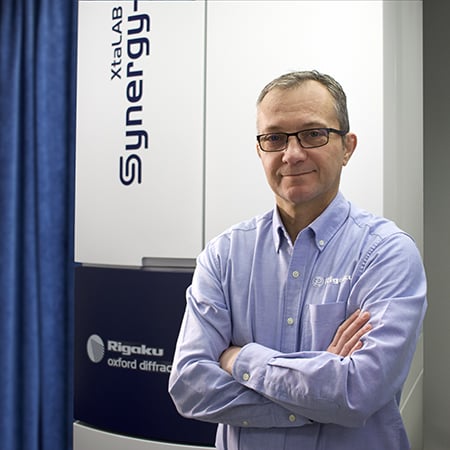Single Crystal X-ray Diffraction
Three-dimensional atomic structures of small molecules may be unambiguously determined by employing the technique of single crystal X-ray diffraction. Such chemical compounds, which may be of either chemical or biological interest, include—but are not limited to—new synthetic chemicals, catalysts, pharmaceuticals, and natural products.
Once a crystal of the compound under investigation has been grown, the complete diffraction pattern—which may consist of thousands of individual measurements—resulting from the interaction of an intense X-ray beam with the crystal is collected on an area detector that can collect a vast number of observations in a single exposure. Automated structure solution is accomplished by analysis of the complex diffraction pattern. This same technique can also be used to produce detailed electron density maps of molecular bonds.
Protein crystallography is a powerful structural biology technique that provides atomic resolution details about proteins and other macromolecular molecules involved in all aspects of life and disease. Rigaku is a world leader in providing instrumentation that can improve productivity at many levels, from making crystallization solutions to automatically mounting crystals and collecting high-resolution X-ray diffraction data sets.

White Paper
This document outlines the operational principles of rotating anodes, their scientific advantages, and integration with modern instrumentation—highlighting why a rotating anode can change your research trajectory as essential tools for high-impact crystallographic research.
Learn more >Products
Application notes
Explore the example analyses to see which analytical technique is right for you.
Customer testimonials
-
I would strongly recommend the system. It is clearly much more powerful and rapid than our previous system.
Read moreDr. Joseph WrightFaculty of Chemistry, University of East Anglia -
I am impressed with the instrument’s performance, and also the software. Furthermore, in my dealings with Rigaku, I have always been listened to as a customer and have received quick responses.
Read moreDr. Henrik FriisNatural History Museum, University Of Oslo -
The new instrument has revitalized our researchers’ interest in using X-ray crystallography as a real-time tool for their science instead of an afterthought or a special circumstance.
Read moreDr. Samantha N. MacMillanX-ray Diffraction Facility at Cornell University -
There has been good help and advice from personnel from Rigaku Oxford Diffraction and I would definitely recommend this instrument to anyone considering making a purchase of a new diffractometer.
Read moreProf. Christine McKenzieUniversity of Southern Denmark -
I would recommend the XtaLAB Synergy-S system for structural biology labs because it is very useful for checking the diffraction quality of protein crystals and allow to collect high-quality data for “non-problematic”, well-diffracting protein crystals.
Read moreDr. Joanna LochFaculty of Chemistry, Jagiellonian University -
The speed of data collection and ease of use has allowed our users to collect a significant number of large data sets that were not previously possible on older systems.
Read moreDaniel UnruhTexas Tech University -
I would recommend the XtaLAB Synergy-S to anyone looking for a ready-to-go system built around the latest technology.
Read moreJames WalshUMass Amherst -
This new machine with a rotating anode generator has been a game changer for our institute. Data from good-diffracting crystals can be collected within minutes!
Read moreDr. Krzysztof RadackiUniversity of Wuerzburg -
The machine is much faster, enabling crystals to be quickly screened to ensure only the best crystals are measured. lt permits small, less perfect crystals to be screened, as well as providing publishable results in a matter of minutes to hours for favourable specimens.
Read moreDr. David WalkerUniversity of Warwick -
The single most important benefit that the instrument brings to the lab is the ability examine very small crystals in a short timeframe, whether that size constraint is forced upon you by the crystal availability, or whether you enforce it in order to isolate a single high-quality fragment from a larger (perhaps multiple) crystal.
Read moreProf. Kenneth ShanklandChemical Analysis Facility, University of Reading -
We get significantly better data with the new instrument. The speed at which we can collect data and solve a structure is impressive. Now, we use fast data collections (minutes long) to work out the connectivity of the compound.
Read moreDr John BacsaCrystallography Lab at Emory University -
The Synergy-R is a fantastic machine and we would unconditionally recommend scheduling a demo, if your institution would like to amplify their lab's capabilities with a high-end diffractometer.
Read moreDr. Michael Wörle, Head and Dr. Nils Trapp, Senior ScientistSmall Molecule Crystallography Center, ETH Zürich -
It is very common for these students to have some initial trepidation and anxiety about using valuable, high powered research equipment, but the approachability of the XtaLAB mini massively reduces this issue.
Read moreSimon Coles and Peter HortonUniversity of Southampton / National Crystallography Service -
What might have started out as one of the usual diffractometer control programs, has evolved into an indispensable tool, which has the ability to obtain very good data, or better, from some of the most challenging samples.
Read moreTony LindenUniversity of Zurich -
Such is the quality of of CrysAlisᴾʳᵒ that it has allowed us to complement studies carried out on synchrotrons and even determine the existence of new crystalline phases not previously detected
Read moreJavier González PlatasUniversidad de La Laguna

Contact Us
Whether you're interested in getting a quote, want a demo, need technical support, or simply have a question, we're here to help.
